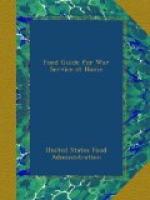The beet-sugar industry in the United States started in 1863 and has grown rapidly since 1897. In 1917 it supplied 22 per cent of the consumption.
Sugar-cane is grown in tropical and semitropical countries all over the globe. Cuba leads in the amount produced, and consumes only a small fraction of her production herself. Java, too, is a large exporter. India raises millions of tons but has to import some to fill all her needs. In the United States, Louisiana, Texas, and some parts of Florida produce about 6 per cent of what we use, but our dependencies, Porto Rico, the Hawaiian Islands and the Philippines all export to us, and together with Cuba, make up the deficiency.
The war has changed entirely the peace-time distribution. The map shows what the battle-lines have done to the beetfields of Europe. Belgium and the northern part of France, in which practically all the beets were grown, are in German hands. In 1914 the battle-line eliminated 203 of the 213 French sugar-factories. In 1916-17 the falling back of the Germans had returned 65 factories to the French, but now again some of these have fallen into the enemy’s hands. The French crop in 1915-16 was only one-fifth of the crop before the war and the following year it was only a fourth. Italy’s crop was 25 per cent less in 1916-17 than before the war and the estimated yield for this year is 50 per cent less. England, of course, can no longer get sugar from the continent.
So the allied world must import cane-sugar or have almost no sugar at all. The cane-sugar supply is largely dependent on shipping. Ships cannot be spared to go to the East. Therefore the sugar of Cuba and the rest of the West Indies, our main source of supply, must be shared with the Allies. It is to the credit of all involved that every effort is being made to see that the division is a fair one. A commission representing the Allies, the United States, and Cuba apportioned the 1917-18 Cuban crop and fixed its price. Competitive bidding by the many purchasers, with the danger of forcing up the price of the limited supply, was in this way prevented.
THE EFFECT OF THE SHORTAGE
The rations of Europe are the most convincing evidence of the extent of the sugar shortage. In England 1/2 pound a week is allowed for each person, half the average amount used in their households before the war. France had sugar cards long before she had any other ration. Seven ounces a week were allowed, and later in the year only one-quarter of a pound. Germany and Austria-Hungary in 1918 had an average household ration of 6 ounces a week.
The United States in accordance with its usual method is asking the individual for voluntary conservation of sugar. Each household is asked to observe a voluntary weekly ration of not more than three-quarters of a pound per person. Extra amounts of sugar for home canning may be secured by making a certified declaration to the dealer that it is to be used only for canning and preserving.




